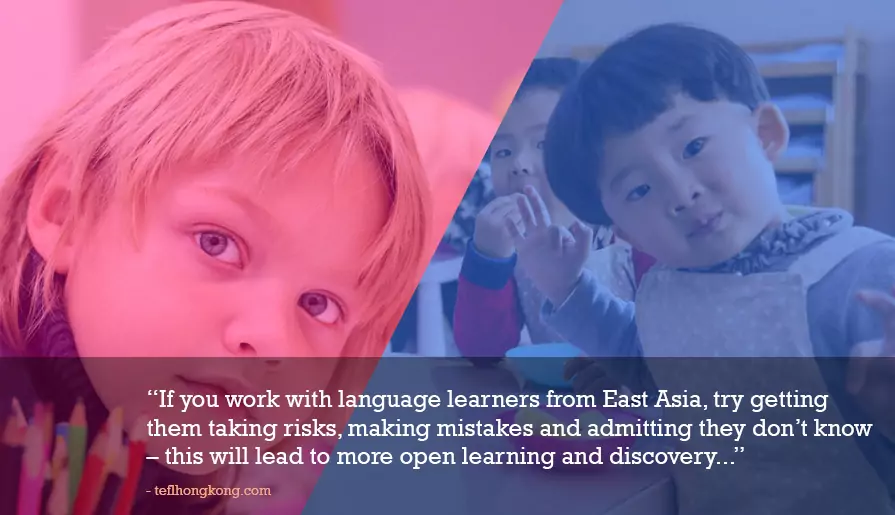
- By: Tom Garside
- In: For Teachers
Working in China, Japan, Korea or Southeast Asia, it doesn’t take long to realise that there are some fundamental differences in the ways in which students approach language, as compared to a typical group of European language learners.
These differences come from a range of factors: educational experience, previous teaching methods that they have been exposed to, assumptions about the nature of teaching and learning, and influences from students’ first language and home culture being just a few.
This article will look at some considerations which language educators can bear in mind to plan how they deliver language-based classes with students from this region of the world.
Competence and performance

Many Asian cultures of education place heavy emphasis on knowledge about language, rather than its application in authentic communication. Language knowledge, otherwise known as language competence, is more easily testable than its real-world application as it can be assessed through grammatical and meaningful examples which can be defined as correct or incorrect according to ‘rules’.
This has an impact on how languages are learned in primary and high-school settings, leading to very high theoretical knowledge of grammar patterns, and perhaps even wide knowledge of vocabulary, without the ability to use this language in communication.
Underdeveloped language performance of this kind is a common feature in learners in the Asia region, a trend demonstrated well by Thai Scrabble experts (and even champions) who cannot actually speak English.
This shows that it is possible to know a huge number of words in a language without being able to use them in a sentence. This extreme example represents an issue that many school students exhibit due to knowledge-focused study and testing.
Paper skills vs oral communication

Connected to the knowledge/performance issue is the imbalance of language skills in many students who have much more highly developed reading and writing skills than speaking and listening skills. Another symptom of a knowledge-based approach to language learning, added to a lack of speaking practice due to large class sizes and the relative unpredictability of spoken language, these factors show the importance of effective oral/aural skills classes for students from this region of the world.
Speaking and listening can be quite daunting for any language learner – unlike reading and writing, where the language being processed is in black and white on the page, spoken language has little visual reinforcement and must be processed in real-time, meaning that a range of different communicative skills are brought into play when having conversations, listening to news, watching movies and so on.
To develop spoken communication skills, it is essential to build confidence, get students to open up with their ideas and opinions, and to create a non-judgmental atmosphere in which anyone can share their ideas freely without risk of embarrassment.
Speaking games are a great way of doing this, and responsive activities where students interrupt, shout out or signal verbally when they hear a specific word, sound or piece of information can increase thinking speed, pro-activity and confidence alongside the language they are studying.
Resistance to errors

Another issue which affects many students’ learning process is the focus on accuracy in language. Any culture of Education which emphasises knowledge-based testing by definition puts great value on correctness.
Unlike many Western education systems, which see errors as part of learning, inaccuracy in student language in many Asian cultures of education is seen as shameful and to be avoided. An effect of this is an aversion to risk-taking in communication.
Students will often stick to language that they are comfortable with, or stay silent rather than confronting the possibility of error. This can significantly slow students’ progress, especially in a classroom designed around a communicative syllabus.
One solution to this fear of errors is to lead by demonstration: everyone makes mistakes, so when you get something wrong, or don’t know an answer, hold your hands up and admit your fault! A classroom which encourages errors in the name of learning will produce more creative, confident and newly-learnt language than one where students are expected to use language that they already know perfectly.
A fear of not knowing is a related barrier to learning – is it possible to learn if you cannot admit that you don’t know something? In a knowledge-based education system, not knowing is often seen as a sign of failure, whereas in the West it is commonly seen as the first step towards a learning moment.
Don’t assume that your students will admit lack of knowledge. Silence is safer than admitting this, so plan these admissions into your classes. Pose questions that you know your learners cannot answer, and reward the ‘I don’t know’ moment.
Once they have admitted this in a controlled, fun environment, they will be more ready to ask questions, discover new ideas and look for the answers that they need independently. It seems like a small step, but hearing students say ‘I don’t know’ for the first time, then finding the answer out for themselves is an immensely rewarding moment for a teacher.
Conclusion:
It is easy to generalise about students from the East and Southeast Asia region (as I have done to some extent above), however every country, district, city and even school works differently to develop language skills in their students.
The factors I outline here, I must stress, are commonly, not always, true, and there are many schools which work hard to combat the issues I describe, turning out rounded language users who have a balance of skills, accuracy and fluency, and can communicate easily despite the focus on assessment which is typical in any primary or high school setting around the world. However, I am speaking generally about common features which I have noted from experience with learners from this region, who have responded very well to the kinds of responsive, interactive and confidence-building techniques used to address the issues above.
If you work with language learners from this region, try getting them taking risks, making mistakes and admitting they don’t know – this will lead to more open learning and discovery in the long run.
Also read:
- How to get your learners speak
- Evidence-based teaching tips
- Why should we use technology in an EFL ESL classroom today?
This article was originally published on August 13, 2019 and was last updated on January 28, 2020.
Courses We Offer:

1. CertTESOL: Certificate in TESOL
A level 5, initial teacher training qualification for new and experienced teachers, enabling you to teach English anywhere in the world. The course is equivalent to Cambridge CELTA.
Learn More
Developed by our Trinity CertTESOL experts, for a comprehensive, self-paced learning experience. Earn an internationally recognized certificate and master essential teaching skills, accessible globally 24/7.
Learn More